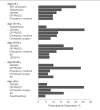Characteristics of opioid prescriptions in 2009
- PMID: 21467282
- PMCID: PMC3187622
- DOI: 10.1001/jama.2011.401
Characteristics of opioid prescriptions in 2009
Figures


References
-
- Fortuna RJ, Robbins BW, Caiola E, Joynt M, Halterman JS. Prescribing of controlled medications to adolescents and young adults in the United States. Pediatrics. 2010;126(6):1108–1116. - PubMed
-
- Vector One: National (VONA) [March 9, 2011];SDI Health. http://www.sdihealth.com/vector_one/services.aspx.
-
- Grant BF, Dawson DA. Age of onset of drug use and its association with DSM-IV drug abuse and dependence: results from the National Longitudinal Alcohol Epidemiologic Survey. J Subst Abuse. 1998;10(2):163–173. - PubMed
-
- Zacny J, Bigelow G, Compton P, Foley K, Iguchi M, Sannerud C. College on Problems of Drug Dependence taskforce on prescription opioid non-medical use and abuse: position statement. Drug Alcohol Depend. 2003;69(3):215–232. - PubMed
MeSH terms
Substances
Grants and funding
LinkOut - more resources
Full Text Sources
Medical

